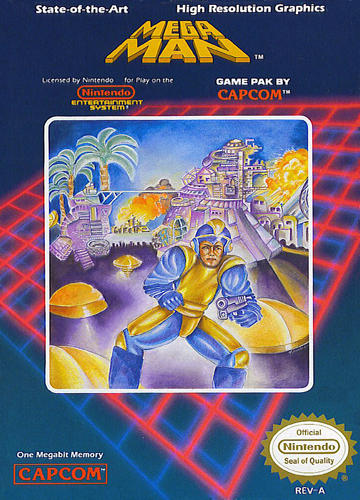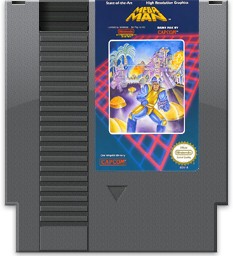

Mega Man, released for the NES in 1987, is a groundbreaking title that introduced gamers to the world of futuristic action-platforming. Developed and published by Capcom, Mega Man captivated players with its challenging levels, innovative boss system, and memorable gameplay mechanics. Let's dive into this timeless classic and explore what makes Mega Man a must-play for any retro gaming enthusiast.
Year: 1987
Manufacturer: Capcom
Genre: Platform
Rating: HSRS - GA (General Audience)
Cover art: In 1987 many of the art covers needed to grasp the buyers imagination. It's an artist's interpretation of what the pixel art is supposed to represent. In most cases the cover art was much better than the cover art. This is one game where the opposite is true. The cover art is horrendous. The Mega Man on the cover of the NES game was soon replaced by the cartoon Mega Boy we know and love today.
Gameplay:
At its core, Mega Man is a side-scrolling platformer that puts you in control of the eponymous blue robotic hero. As Mega Man, your mission is to defeat a group of rogue Robot Masters and thwart the nefarious plans of the evil Dr. Wily. Each Robot Master has a unique stage, featuring its own theme, hazards, and enemies.
What sets Mega Man apart is its ingenious boss system. After completing each stage, players confront a Robot Master in an intense one-on-one battle. Defeating a Robot Master grants Mega Man a new weapon, allowing players to exploit the weaknesses of other bosses. This strategic element adds depth and replayability to the game, as players can experiment with different weapons to find the most effective combinations.
The level design in Mega Man is outstanding. Each stage presents a distinctive theme, such as Fire Man's scorching lair or Elec Man's electrifying maze. The platforming challenges are meticulously crafted, requiring precise timing and reflexes. Hidden secrets and collectibles further enhance the exploration aspect, rewarding attentive players with power-ups and extra lives.
Graphics and Sound:
While the NES's graphical capabilities were limited, Mega Man pushed the system to its limits with vibrant and detailed sprite work. The character designs of Mega Man and the Robot Masters are iconic, and the environments are varied and imaginative. The game's art style captures the futuristic aesthetic perfectly, immersing players in Mega Man's world.
Accompanying the visuals is a memorable soundtrack composed by Manami Matsumae. Each stage has its own unique theme that perfectly complements the gameplay and atmosphere. From the catchy tunes of Cut Man's stage to the energetic beats of Guts Man's theme, the music of Mega Man adds an extra layer of enjoyment to the overall experience.
Legacy and Impact:
Mega Man's impact on the gaming industry cannot be overstated. It spawned a long-running franchise that has endured for decades, with numerous sequels, spin-offs, and adaptations across various consoles. The game's innovative boss and weapon system influenced countless titles in the action-platforming genre, and its challenging gameplay and tight controls set the standard for future games in the series.

Conclusion:
Mega Man for the NES remains a timeless gem in the world of video games. Its solid gameplay, memorable characters, and ingenious boss system make it a must-play for any retro gaming enthusiast. Whether you're a fan of challenging platformers or simply appreciate gaming history, Mega Man deserves a spot in your collection. It's a testament to the creative brilliance of Capcom and the enduring legacy of one of gaming's most iconic franchises.
Explore in-depth reviews and analyses of classic Nintendo Entertainment System (NES) games, including gameplay mechanics, graphics, sound, and overall nostalgic experience.